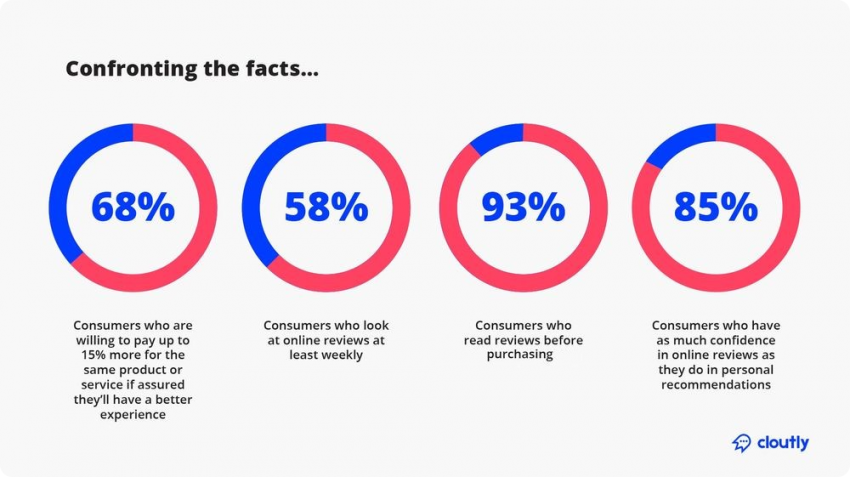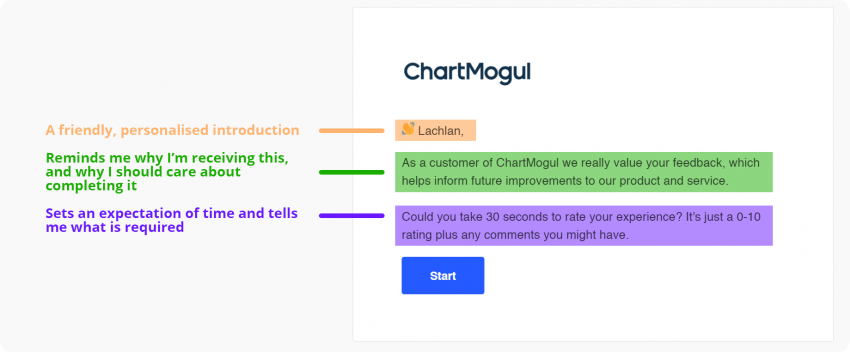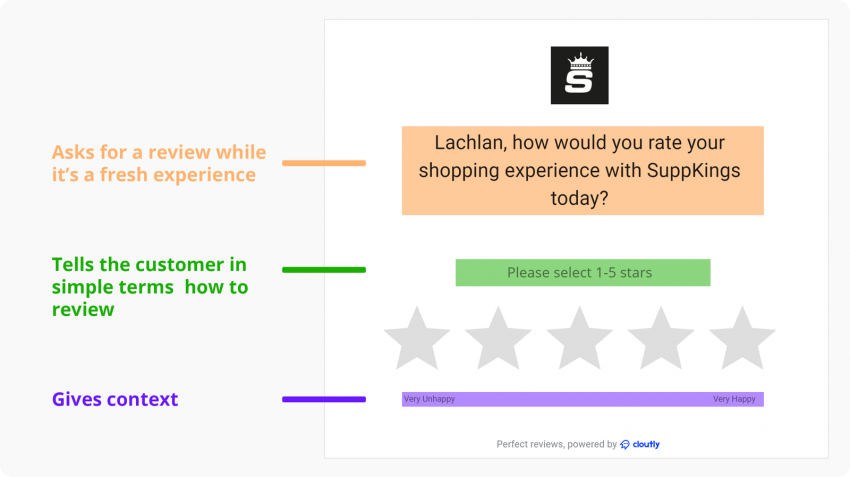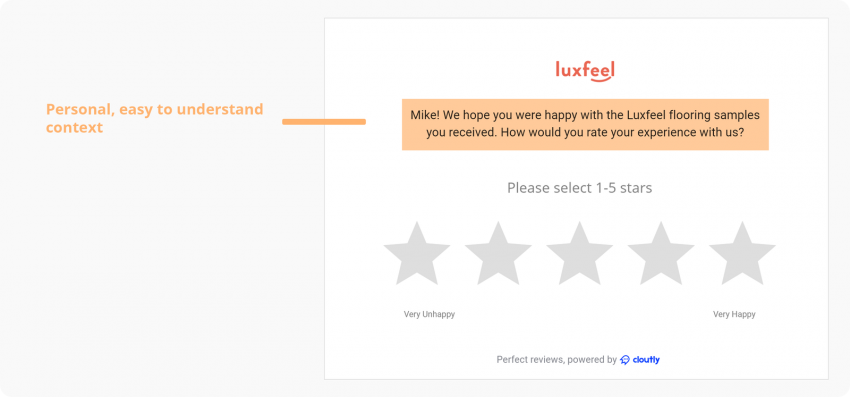Many businesses will put all their effort into marketing collateral but might forget about one of the most convincing and authentic mediums – customer reviews.
Acting as a personal recommendation for your product/service, customer reviews are one of the most effective forms of social proof. About 68% of customers will deal with a business because of positive reviews. Moreover, online reviews reduce the skepticism usually linked to adverts or your social posts.

But how to ask for reviews without being too abrasive, on the one hand, and without being greeted with radio silence, on the other hand?
In this post, we’ll answer the most frequently asked questions about this activity, so you can add it to your marketing agenda with utmost confidence. Off we go!
Asking for reviews: when’s the right time?
It can feel awkward to approach previous customers and ask them to write a review about your business. But the truth is: if you don’t ask, the chances you’ll get a review are meager.
The first question you should have when wondering how to ask for reviews is: when is the right time to ask for reviews?
To determine the optimum time to ask for a review, ask yourself three questions:
- In what part of the buying journey is your customer the most content?
- Will your customer write a good review now, or should you wait a bit longer?
- When will your customer expect to receive a review request?
Clearly, each business is different, and you know your customers better. Therefore, with time, you’ll understand when your request is most welcome.
But overall, I recommend you ask for reviews at the peak of the customer experience (when they’re the happiest with you). At this moment, you’ll be more prominent in their mind, hence more likely to get a positive review.
What should you say when asking for reviews?
When asking your customers to write a review about your business, think about what would trigger them to review you and how to communicate your request in the most approaching way.
Use the following tips:
Be simple
This is your time to flex those copywriting muscles. Use non-sophisticated language – as if you’re talking to a friend.
A simple “How did we do?” looks more human and casual than “Please leave a rating for us to indicate your judgment of our recent performance.” Remember: you’re not a robot, and neither is your customer.
For example, ChartMogul uses a friendly approach to asking for reviews without being too pathetic about it:

In addition, use words that would trigger emotions and encourage your customer to do the action. Just remember to keep it in line with your brand voice.
Be up to a point and clear
Explain why you’re asking customers to write a review now. Is it because they bought something from your business that day? Or is it because they bought something last week? By stating the reason, you ensure your request is not out of the blue.
It’s also good to tell your customers how easy it is to review you (and how long it will take). Cut to the point. And let them know how much you would appreciate it.
For instance, while asking customers to review their experience, SuppKings states it takes only 30 seconds, so users understand it will be easy and fast.

Personalize
Make sure you add a personalized approach to your review request. Say, if you address your customer by name, this human element will make them more inclined to proceed with your plea.

The best format to ask for reviews
There are plenty of ways to get in touch with your customers to ask for a review:
Emails
Sending an email to your customer is the most common and effective way to ask for reviews. Here is why:
- Email is the most popular communication channel: about 86% of professionals prioritize email connection.
- Email is an unobtrusive way of communication since it allows the recipient to reply at the most convenient time.
- Email gives lots of room for personalization (you can use email variables, embed personalized visuals, etc.).
Phone calls
Even if you’re used to pelting your phone far, far away from you if someone dares to call, some people out there still enjoy a chat on the phone. Therefore, calling your customers with the aim of asking for a review may be quite effective.
It helps build relationships, and if there is a negative issue with your business, you can figure and sort it out quickly on the phone. This means you’ll dodge a negative review and increase your chances of a positive one.
Video messages
You can combine email with a video review request and make the latter even more efficient. Sending a video message through text or email is a surefire way to grab your customer’s attention.
Here are some reasons why video review requests work:
- They allow your potential customers to visually and audibly understand the importance of their feedback about your business.
- They are engaging. If a video pops up in your customers’ inboxes, they’ll be intrigued to watch it.
- Videos have a higher retention rate (your customers are less likely to get tired of watching a video than reading a text request).
- Videos are easy to share and may be stored on your company channel, so every customer may bump into them.
Social media platforms
Don’t underestimate the power of social media while asking for reviews. Through your social media accounts, you can:
- Run giveaways based on customer reviews.
- Get your customers to tag you in their product posts, which you can re-share (people love their chance in the spotlight, especially if you have an extensive following base).
- Use direct messages to ask for feedback and specific reviews on your products/services.
- Create a special community, like a Facebook group, to speak to people about your product or service and encourage them to leave reviews.
QR codes
With QR codes, you can ask for customers’ reviews without access to their contact information, such as email address or phone number. It’s a unique way to ask for a less invasive review.
Simply download a QR code generator such as Cloutly’s free QR code generator and place the QR code on your product, website, social media page, or whatever else.
Cards with handwritten notes
Nothing looks more personalized than a handwritten note. This might sound old school, but it’s a personal touch still very much appreciated today.
Сards with handwritten notes are a great way to ask for a review after a purchase. So, don’t forget to leave one for your customer with a thank-you message. It also allows you to direct your customers to one of your social media accounts.
Just don’t be too pushy. With your heartfelt words, include a link to your review page or a QR code. Otherwise, your good intentions might seem a bit jaded if it’s a specific, outright review request.
In-person
Another way of requesting a review (for physical, not online stores) is to ask your customer for a review in person as you hand over the product they’ve just purchased.
It’s prime time. You are fresh in their mind, so slipping them your card with QR and providing easy instructions on how to leave a brief review is the best you can do at the moment.
Review request campaigns: do you need one?
Whichever format you choose to use to ask for a review, remember that people are busy. You might need to gently remind your customers to review you, and this means giving them a few chances.
Setting up a review request campaign can guarantee more reviews than the odd message sent out.
Use email as a way to communicate with your customers. You can send out your review requests with slight alterations to the text or video. Whichever form you use. Follow up with 2-3 reminders (but stop there) and ensure your messaging remains clear and personalized.
The best way to set up a review campaign is to use the Snov.io Email Drip Campaigns tool. This way, you can create personalized campaigns with automatic follow-ups and track your open and click-through rates to see what’s working and what’s not.
What about testing?
When it comes to asking for reviews, there might be a bit of trial and error.
Much like your email campaigns, you might run A and B testing to see which emails are better engaged with. You can do the same for your review requests.
For example, you can test out which form of review request (email or phone) performs better or test two different emails (with the embedded video or without) and adjust your future email request campaigns based on the metrics.
In a customer-centric market, communication can vary. This means that adjusting your customer interactions over time to the customer’s needs will help you stay connected and more relevant.
Should you include review incentives?
Offering your customers small incentives may be used by you as a ‘thank you’ gesture for their writing several positive lines about your product or service.
However, there’s an issue with incentivizing your customers to write reviews.
First, a technical problem exists: using gifts or discounts to encourage customers to review you goes against the terms and conditions of many review sites such as Google and Yelp. For instance, Google’s content guidelines do not allow review incentives, and you might get blocked or fined.

And there is an ethical problem: requesting reviews through offering incentives creates an artificial trust economy. The credibility of such reviews can be questioned when there’s been some influence over them by the business itself.
What to do with your reviews once you get them?
The hard part’s over. You can breathe and bask in the light of your shiny, new 5-star reviews.
Now that you’ve got them, you need to put them on the web. Show them up on all of the review sites to which you directed your customers. But don’t stop here. It would be best if you implemented reviews into your marketing channels.
As for the text reviews, for instance, embed them into your website’s homepage. If you’ve requested video testimonials from your customers, it’s time to start plugging those across your website and social media accounts.
You can even use reviews as an advert on Facebook or Instagram, and they’ll pop up in your target demographics’ stories. They’ll seamlessly fit in with the other videos on the platform and will captivate your audience.
Just remember: it’s about showcasing your authentic social proof as much as possible. You’ve effectively achieved bragging rights.
Are there any special tools to automate review requests?
There’s an easier way to build your social proof online rapidly. With review management tools like Cloutly, you can ask all of your customers for reviews and direct them to any review site you choose (such as Facebook, Google, Tripadvisor, etc.).
It’s the most effective way to bring all of your reviews into one place, drive more reviews, and showcase those reviews with our epic review widgets.
You can even use Cloutly email templates when you’re asking for reviews, personalize them, and shoot them out to the masses.
Cloutly is available for free for 14 days, so you can try its functionality and see if you can resist using it long-term.
Wrapping up
Reviews are effortless marketing collateral to convince prospective customers to try your brand. Above, we’ve provided answers to the most frequently asked questions about how to ask for reviews. If you’ve got more questions, feel free to ask in the comments to this post.
We hope requesting email reviews will become part of your marketing routine!




